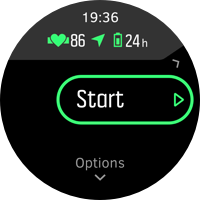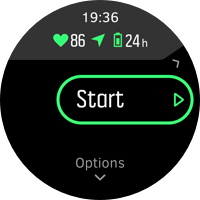HR belts measure your heart rate by picking up the electrical signals of your heart with the electrodes on the textile belt, and sending them to the module attached. To make sure you get the best results, please follow these tips:
- The electrodes on the belt and/or the area of the skin where they touch should be moistened before starting the exercise. Especially in dry and cold periods, using a water-based contact gel on the skin guarantees the best results.
- The belt needs to be placed correctly on the chest. It should be under the sternum, with the module in the middle and it needs to be tight enough so that it doesn’t move.
- The electrodes, and the areas in the belt where the module connects, need to be clean. The textile belt (without the module) should be rinsed after every use, and it should be washed regularly (every 3-5 uses, or every week). The best way to wash it is at 30°C in a washing machine, without tumble drying.
- Battery normally lasts 300 to 500 hours: make sure to regularly replace the battery. When you replace the battery, carefully clean and reposition correctly the O-ring, otherwise water resistance could be compromised causing damage to the module.
It’s extremely rare for issues to be caused by the watch – usually the cause is how the belt is used or issues with the textile belt. Here are some of the common issues, how to identify them and address them:
- The data is irregular or stuck at the beginning of the workout for a few minutes, and then it stabilizes. This is usually caused by lack of moisture: try to moisten the electrode area plentifully or use contact gel the skin.
- Heart rate data is incorrect: the data is irregular, with unrealistic peaks over 200/220 BPM, all along the activity, or the data has several long flatlines and vertical jumps/drops over the course of the activity.
- No heart rate at all: the watch doesn’t find the heart rate belt before the start of the activity, or the value shown is two dashes (--) instead of the actual value.
NOTE: If you are using a watch with an optical heart rate sensor and you have a heart rate belt paired with your watch, the heart rate icon on the exercise start screen will show a small belt around the heart. If the icon instead shows a heart without the belt, the heart rate belt is not connected or not found, and optical heart rate is used instead
Heart rate belt in use 
Optical heart rate in use 
What you can do:
- Try to replace the battery, being careful to clean the O-ring and position it correctly after placing the new battery in place. TIP: Sometimes static energy might be stored in the electrodes, and battery being used even if you are not wearing the belt. To preserve the battery, detach the module from at least one of the contacts on the belt when you are not using it.
- Try to Pair the watch and heart rate sensor again, as explained in the user guide of your watch.
- The heart rate textile belt might be dirty. Please wash it carefully with warm water (the best way is to use a washing machine at 30°C, without tumble drying). Pay attention to remove any residue of limestone, dirt, dried sweat from the electrodes area and the contact areas.
If none of this helps, it is likely that the textile belt is worn out and not working correctly, and it needs to be replaced. NOTE: the warranty on the textile belt part of the Suunto Smart Heart Rate belt is one year. If your belt is still covered by warranty, we can ship a replacement out to you. Get in touch with our customer support team and they will be able to help. Otherwise, if the belt is older than one year, you can find textile belts for Suunto heart rate sensors for sale here (Check your size before buying!).
NOTE: battery replacement is not covered by warranty. Sending to our service centera heart rate sensor that needs the battery replaced will result in a charge.